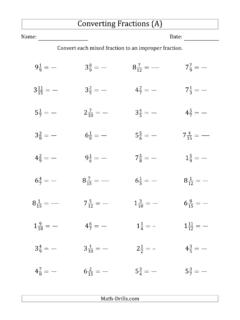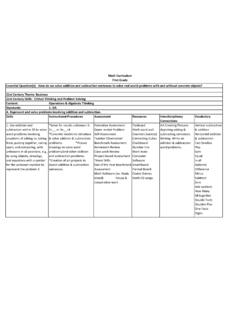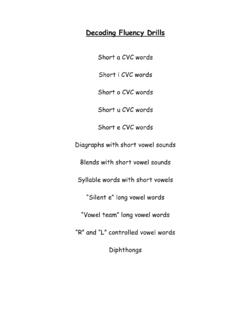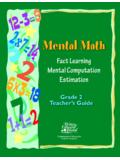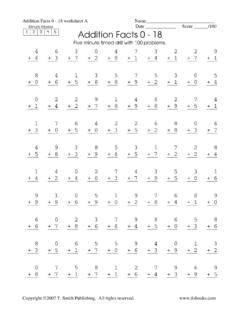Transcription of Divisibility Rules Workbook - Math6.org - Free Math ...
1 Name _____. Divisibility A number is divisible by another number if it is a true multiple of the other number (or if the division problem does not have a remainder. 24 is divisible by 3 because 24 3 = 8 with no remainder. 25 is not divisible by 3 because it would have a remainder of 1! This first section of this booklet will help you to learn the Divisibility Rules that you will need and use every day. The numbers are all less than 169 because using the Fraction Actions method, you will never end up with numbers greater than 169 that are not already finished numbers. The last section of the book will help you with a few Rules that you will need to know for NC EOG testing purposes. Divisibility Rules Divisibility Rule for 2. When the last digit in a number is 0, 2, 4, 6, or 8, the number is divisible by 2.)
2 Divisibility Rule for 5. When the last digit in a number is 0 or 5, the number is divisible by 5. Divisibility Rule for 3. When the sum of the digits is a multiple of 3, the number is divisible by 3. Divisibility Rule for 7. Double the last digit in a number and subtract it from the rest of the number. If the result is a known multiple of 7, then the number is divisible by 7. If the result is not known, repeat the rule with the new number! Divisibility Rule for 11. When the sum of the odd digits is equal to (or 11 more than) the sum of the even digits, the number is divisible by 11. Divisibility Rule for 13. Nine times the last digit in a number and subtract it from the rest of the number. If the result is a known multiple of 13, then the number is divisible by 13. If the result is not known, repeat the rule with the new number!
3 Divisibility Rule for 4. When the last 2 digits in a number are a multiple of 4, the number is divisible by 4. Divisibility Rule for 6. When a number is divisible by 2 and 3, the number is divisible by 6. Divisibility Rule for 9. When the sum of the digits is a multiple of 9, the number is divisible by 9. Divisibility Rule for 10. When the last digit in a number is 0, the number is divisible by 10. 2009 Norm Mitchell ( ) All Rights Reserved Freely reproducible for non-profit educational purposes visit for more details concerning non-profit . Divisibility (2 and 5). Lesson Box Models The Divisibility rule for 2 and 5 ask you to look at the 2, 5 80. last digit of the number. 80 ends with 0. According to the Rules , numbers that If the last digit is 0, 2, 4, 6, or 8 the number is divisible end with 0 are divisible by 2 and 5.
4 By 2. If the last digit is 0 or 5, the number is divisible by 5. 2 158. 158 ends with 8. 8 is part of the 2 rule. 151. 151 ends with 1. 1 is not part of either rule, so 151 is not divisible by 2 or 5. 5 215. 215 ends with 5. Twenty-five is divisible by 5! Apply the Divisibility Rules for 2 and 5. If the number is divisible by 2 or 5, write which ever answer is true. You do not need to write both answers. (example: 110 is divisible by both 2 and 5, you may answer 2) If the number is not divisible by these Rules , enter . _____ 160 _____ 145 _____ 107 _____ 37 _____ 41. _____ 80 _____ 136 _____ 115 _____ 20 _____ 156. _____ 158 _____ 133 _____ 120 _____ 137 _____ 59. _____ 151 _____ 124 _____ 35 _____ 105 _____ 34. _____ 76 _____ 78 _____ 141 _____ 24 _____ 112. _____ 25 _____ 106 _____ 159 _____ 23 _____ 162.
5 _____ 108 _____ 36 _____ 44 _____ 68 _____ 61. _____ 66 _____ 103 _____ 111 _____ 167 _____ 100. _____ 87 _____ 73 _____ 157 _____ 67 _____ 96. _____ 72 _____ 130 _____ 46 _____ 54 _____ 30. _____ 29 _____ 154 _____ 74 _____ 89 _____ 99. [use Key 1 to check your answers]. Divisibility (3). Lesson Box Models The Divisibility rule for 3 asks you to find the sum of 3 138. the digits. 1 + 8 = 9 (or 1 + 3 + 8 = 12). If the sum of the digits is a multiple of 3, then the number is divisible by 3. 58. 257 5 + 8 = 13. 2 + 5 + 7 = 14. 14 is not a multiple of 3. 257 is not divisible by 3. 3 126. 342 1 + 2 = 3 (or 1 + 2 + 6 = 9). 3 + 4 + 2 = 9. 9 is a multiple of 3. 342 is divisible by 3. 101. To cast out 3's don't add any 3, 6 or 9's. 1+1=2. 342 4 + 2 = 6. 268 2 + 8 = 10. 692 2 = 2. Apply the Divisibility rule for 3.
6 If the number is divisible by 3, write 3. If the number is not divisible by 3, enter . _____ 47 _____ 164 _____ 54 _____ 156 _____ 108. _____ 70 _____ 68 _____ 137 _____ 55 _____ 117. _____ 122 _____ 77 _____ 92 _____ 107 _____ 106. _____ 140 _____ 61 _____ 83 _____ 87 _____ 31. _____ 169 _____ 148 _____ 141 _____ 78 _____ 41. _____ 51 _____ 145 _____ 56 _____ 96 _____ 74. _____ 111 _____ 46 _____ 90 _____ 155 _____ 19. _____ 60 _____ 64 _____ 44 _____ 72 _____ 124. _____ 86 _____ 81 _____ 75 _____ 167 _____ 36. _____ 100 _____ 131 _____ 159 _____ 134 _____ 95. _____ 38 _____ 119 _____ 166 _____ 69 _____ 59. _____ 14 _____ 26 _____ 50 _____ 40 _____ 29. [use Key 2 to check your answers]. Divisibility Drills 2, 3 and 5. Apply the Divisibility Rules for 2, 3 and 5. If the number is divisible by 2, 3 or 5, write which ever answer is true.
7 You do not need to write all of the answers. (example: 110 is divisible by both 2 and 5, you may answer 2) If the number is not divisible by these Rules , enter . _____ 103 _____ 75 _____ 65 _____ 30 _____ 139. _____ 24 _____ 112 _____ 28 _____ 105 _____ 123. _____ 53 _____ 143 _____ 64 _____ 26 _____ 136. _____ 49 _____ 90 _____ 164 _____ 140 _____ 96. _____ 50 _____ 152 _____ 111 _____ 104 _____ 125. _____ 31 _____ 81 _____ 145 _____ 71 _____ 113. _____ 169 _____ 107 _____ 95 _____ 131 _____ 129. _____ 19 _____ 165 _____ 149 _____ 29 _____ 124. _____ 36 _____ 127 _____ 137 _____ 84 _____ 109. _____ 141 _____ 32 _____ 63 _____ 100 _____ 14. [use Key 3 to check your answers]. Apply the Divisibility Rules for 2, 3 and 5. If the number is divisible by 2, 3 or 5, write which ever answer is true. You do not need to write all of the answers.
8 (example: 110 is divisible by both 2 and 5, you may answer 2) If the number is not divisible by these Rules , enter . _____ 55 _____ 48 _____ 98 _____ 40 _____ 83. _____ 119 _____ 155 _____ 130 _____ 151 _____ 157. _____ 51 _____ 106 _____ 116 _____ 135 _____ 27. _____ 17 _____ 70 _____ 25 _____ 117 _____ 42. _____ 120 _____ 156 _____ 160 _____ 62 _____ 34. _____ 101 _____ 41 _____ 133 _____ 121 _____ 72. _____ 153 _____ 146 _____ 159 _____ 148 _____ 45. _____ 44 _____ 134 _____ 167 _____ 122 _____ 79. _____ 162 _____ 161 _____ 67 _____ 168 _____ 126. _____ 154 _____ 12 _____ 110 _____ 85 _____ 23. [use Key 4 to check your answers]. Divisibility (7). Lesson Box Models Double the last digit in a number and subtract it from the rest of the number. 138. If the result is a known multiple of 7, then the number is divisible by 7.
9 8*2 = 16 ; 16-13 = 3 ; 138 is not divisible by 7. If the result is not known, repeat the rule with the new number! 7 168. 257. 8*2 = 16 ; 16-16 = 0 ; 168 is divisible by 7. 7 * 2 = 14. 25 14 = 11. 257 is not divisible by 7. 7 133. 343. 3*2 = 6 ; 13-6 = 7 ; 133 is divisible by 7. 3 * 2 = 6. 34 6 = 28. 343 is divisible by 7. 101. 49. 1*2 = 2 ; 10-2 = 8 ; 101 is not divisible by 7. 9 * 2 = 18. 18 4 = 14. 49 is divisible by 7. (notice you can subtract the first digits from the doubled last if you need to!). Apply the Divisibility rule for 7. If the number is divisible by 7, write 7. If the number is not divisible by 7, enter . _____ 46 _____ 117 _____ 139 _____ 66 _____ 70. _____ 55 _____ 161 _____ 140 _____ 31 _____ 69. _____ 111 _____ 153 _____ 35 _____ 63 _____ 119. _____ 49 _____ 132 _____ 105 _____ 13 _____ 78.
10 _____ 141 _____ 28 _____ 93 _____ 110 _____ 130. _____ 156 _____ 88 _____ 121 _____ 143 _____ 95. _____ 15 _____ 155 _____ 54 _____ 21 _____ 136. _____ 60 _____ 166 _____ 72 _____ 23 _____ 123. _____ 133 _____ 59 _____ 167 _____ 17 _____ 107. _____ 92 _____ 160 _____ 45 _____ 168 _____ 145. _____ 30 _____ 102 _____ 43 _____ 68 _____ 41. _____ 152 _____ 142 _____ 83 _____ 149 _____ 124. [use Key 5 to check your answers]. Divisibility Drills 2, 3, 5, and 7. Apply the Divisibility Rules for 2, 3, 5 and 7. If the number is divisible by 2, 3, 5 or 7, write which ever answer is true. You do not need to write all of the answers. (example: 110 is divisible by both 2 and 5, you may answer 2) If the number is not divisible by these Rules , enter . _____ 163 _____ 95 _____ 128 _____ 81 _____ 18. _____ 142 _____ 29 _____ 38 _____ 149 _____ 40.





